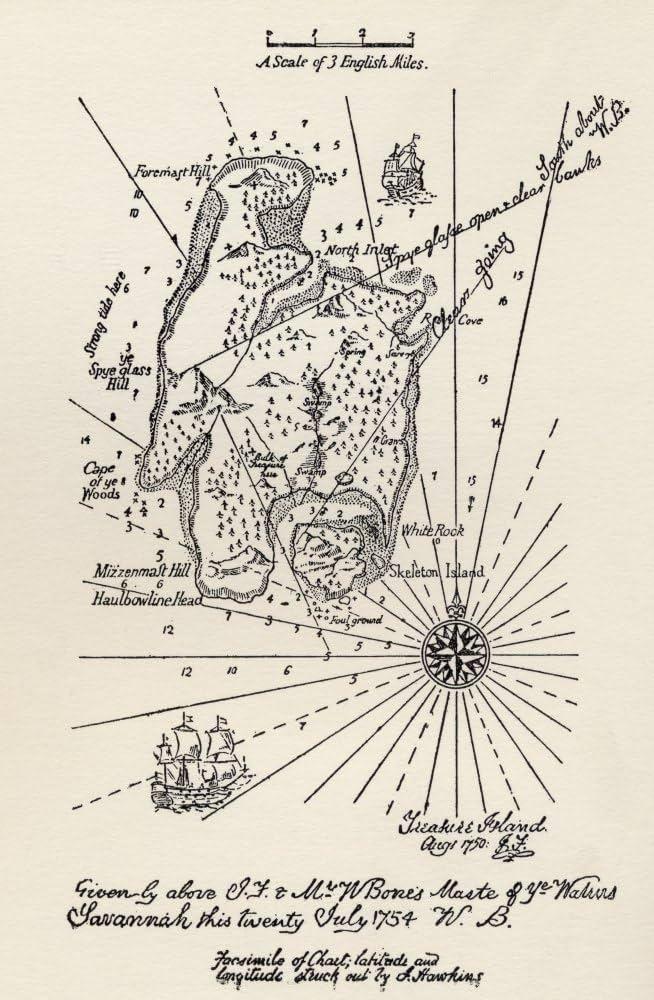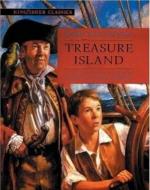Created by Nathaniel Lewis on Tue, 10/15/2024 - 15:16
Description:
Treasure Island is an adventure novel written by Robert Louis Stevenson for young boys during the Victorian Era. As the nineteenth century was unfolding, children's literiture began moving away from didacticism and towards entertainment. Ever sinse he was a yound lad, Robert Louis Stevenson was filled with a desire to venture out and explore the world, but was held from doing so due to weak lungs and an expectation that he would follow in his father's footsteps as a light house engineer. At the age of twenty-five, Robert Louis Stevenson graduated from the University of Edinburgh with a degree in law in 1875, but instead chose to pusue a career path in literature. His first book would begin in the summer of 1881 when he drew a map to entertain his step-son on a rainy day. That map would then serve as the basis for Stevenson's first ever published book Treasure Island. In Treasure Island, Robert Louis Stevenson presents the reader with a young boy by the name of Jim Hawkins who goes on an adventure to a faraway island in search of buried treasure and faces off against piarates. As the story unfolds, Jim developes from a meek little boy who was afraid of piarates and leaving his Mother and home behind, to a man who courageoulsy faces down bloodythirsty piarates at the cost of his own safety. The original copy of Treasure Island, had no illustrations, but the years following, new editions would be printed that would feature illustrations from different authours, and much later movie adaptations would be made. As we see Treasure Island media develope over the many years since the first edition, we can take notice of how like Jim Hawkins, the art becomes both more mature and more adventurous, and how the artstyles of different illustrators can make two moments seem entirly different.
Treasure Island, as a story serves two purposes. The first one is for Robert Louis Stevenson to live out the adventures he could never go on, and the second is encourage young boys to seek out those adventures themselves. Through his writing, Robert Louis Stevenson creates a story that teaches young boys how to be proper and patriotic Victorian men, while also creating an entertaining piece of literature that inspires young readers even to this day.
John Lawerence, Cover for Treasure Island (1883), by Robert Louis Stevenson, Kingfisher Publications 2001. Treasure Island at its core is an adventure novel made for young boys like the Jim Hawkins who appears on the cover of this edition. In a time before airtravel became possible, the ship was the primary mode of transport across wide ranging oceans, and thus became a symbol of adventure and discovery. With Jim Hawkins at the helm of the ship, this cover evokes the sense of adventure that is Treasure Island, and gives its readers a sense of the excitment that will unfold as they read through the story of Treasure Island.
Georges Roux, "Jim's Farewell," for Treasure Island (1883), by Robert Louis Stevenson, 1885 edition. Following the release of Treasure Island, the French illustrator Georges Roux was comisioned to make drawings for an illustrated version of the book that released in 1885. As the first illustrated version of Treasure Island, the 1885 edition can be counted as the first time an illustrator would adapt a portion of the story into a visual format. In this particular image we have Jim Hawkins tearfully embracing his mother as he is about to leave for his journey to treasure island. This image is particularly striking as it is one of the few illustrations where we see Jim Hawkins being particularly vulnerable, reminding the us that while Treasure Island is a tale about what it means to be a man, Jim Hawkins (and its intended audience) is still a boy. By having us Jim Hawkins show off more boyish qualities in the begining, Georges Roux gives readers a sense of the growth that Jim will attain as he travels to the island and faces off aginst Long John Silver's crew.
N.C. Wyeth, "Jim's Courage Manifests," for Treasure Island (1883), by Robert Louis Stevenson, 1911 edition. When Jim sneaks aboard the Hispanola he encounters the steersmen of the ship, Israel Hands. Until Hands, Jim had spent most of his adventure running and hiding from pirates, which makes his decision to return to the Hispanola to steal it back from the pirartes, a very significant moment for him. When Jim encounters Hands he has the option to flee back to the fortress, but instead chooses to face off against Hands even at the risk of his own life. While Jim's desision to go out on his own and face Hands is indeed reckless, it is also arguably one of his first truly courageous moments in Treasure Island. Jim's couragous act not only proves to be a big help to him and his crew later, but also shows how Jim has grown up since he left his home.
Various Artists, "Treasure Planet," 2002. In Disney's Sci-fi adaptation of Treasure Island, Treasure Planet sees a teenage version of Jim Hawkins traveling across the galaxy to a faraway planet in search of Captain Flint's treasure and facing off against mutinous pirates led by a cyborg version of Long John Silver. While the story being set in space might seem like the bigest digression from the source material, what really sets Treasure Planet apart from its contemporaries is the way it developes its relationship between Jim Hawkins and Long John Silver. In Treasure Planet, Jim's father abandons him rather than dies and we see Silver take up the mantel of Jim's father figure, teaching him important life lessons and protecting him from danger. At the start of Treasure Planet, we see Jim constantly getting into trouble due to the lack of guidence from his father showcasing how a having a persons father can greatly influence the development of children like Jim. In becoming the father Jim never had, Silver helps guide Jim into becoming a more capable, and confident version of himself. By expanding on Sliver and Jim's relationship, Treasure Planet shows us how fathers can play big part in what kind of a man people like Jim become, wheather they are present in or not.






